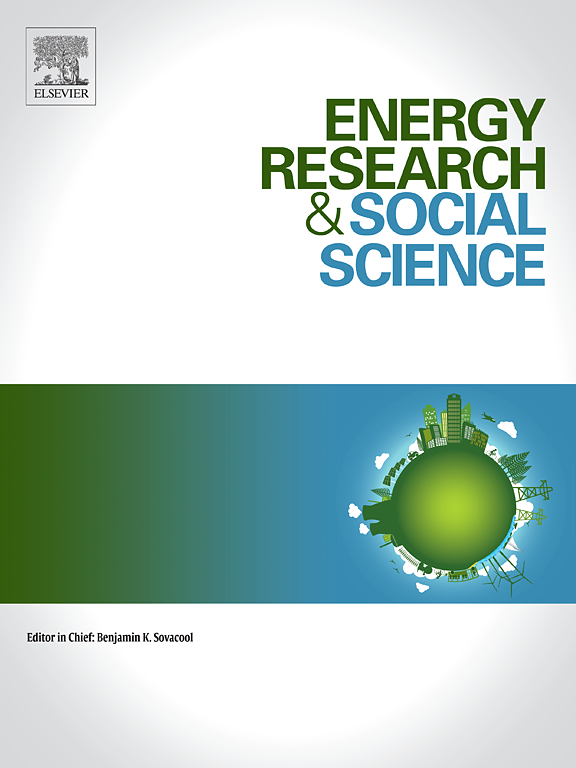绿色复苏还是化石能源锁定?评估主要经济体的可持续性和能源转型路径
IF 6.9
2区 经济学
Q1 ENVIRONMENTAL STUDIES
引用次数: 0
摘要
本研究分析了新冠肺炎危机后,绿色复苏政策在多大程度上成功触发了全球最大经济体的能源转型。这场危机提供了一个短期政策窗口,通过这个窗口,财政刺激可以与脱碳目标相结合,但政策从雄心、实施到影响不一。通过投资分布分析(IDA)、基于卡亚身份的排放影响评估和能源转换率(ETR)模型的正式多方法框架,本研究评估了大流行后恢复计划在多大程度上实现了绿色能源转型。研究结果表明,绿色复苏的言论与预算行动之间存在巨大差异。在印度和巴西,超过67%的恢复支出用于短期经济稳定,将可再生能源发展(RED)和绿色就业与可持续发展(GJS)的融资水平降至微不足道的水平。英国、法国和加拿大也不例外,即使在签署了气候承诺后,RED和GJS占总支出的比例仍低于10%。中国在绝对排放量更高的情况下实现了效率提高;2015年至2023年间,中国的净二氧化碳排放量从11.02略微上升至11.22 GtCO₂e,但其Kaya倍数从10.19显著下降至8.29,表明单位经济产出的排放强度有所下降,结构性效率略有提高。德国和法国的排放量在疫情后出现反弹。能源转型率差异很大:巴西和中国的可再生能源与化石能源之比分别增长了50%和100%,而加拿大和英国则停滞不前或下降。这些长期瓶颈包括对电网现代化投资不足、政策不连贯以及过渡框架不充分。报告的结论是,绿色复苏需要的不仅仅是资金,还需要更多的制度协调、公平整合和长期监管承诺,以实现转型变革。本文章由计算机程序翻译,如有差异,请以英文原文为准。
Green recovery or fossil lock-in? Assessing sustainability and energy transition pathways in major economies
This study analyzes the degree to which green recovery policies have succeeded in triggering energy transitions among the world's largest economies after the COVID-19 crisis. The crisis provided a short-term policy window through which fiscal stimulus could be integrated with decarbonization objectives, yet policies ranged from ambition, implementation, to impact. Through a formal multi-method framework of Investment Distribution Analysis (IDA), Emission Impact Assessment via the Kaya Identity, and Energy Transition Rate (ETR) modeling, this research evaluates the extent to which green energy transitions were enabled by post-pandemic recovery programs. Findings demonstrate substantial disparity between green recovery rhetoric and budgetary action. In India and Brazil, over 67 % of recovery expenditure was aimed at short-term economic stabilization, reducing financing levels for renewable energy development (RED) and green jobs and sustainability (GJS) to negligible levels. The UK, France, and Canada are no exception, as RED and GJS fell below 10 % of total spending even after they had signed their climate commitments. China achieved efficiency improvements despite higher absolute emissions; between 2015 and 2023, its net CO₂ emissions rose slightly from 11.02 to 11.22 GtCO₂e, yet its Kaya Multiple declined significantly from 10.19 to 8.29—indicating reduced emissions intensity per unit of economic output and modest structural efficiency gains. Germany and France saw post-COVID rebounds in emissions. Energy transition rates were wildly divergent: Brazil and China saw 50 % and 100 % increases in renewable-to-fossil energy ratios, while Canada and the UK saw stagnation or decrease. These long-term bottlenecks consist of underinvestment in grid modernization, policy incoherence, and inadequate just transition frameworks. The report concludes that green recovery requires more than finance—more institutional alignment, integration of equity, and long-term regulatory commitment to deliver transformative change.
求助全文
通过发布文献求助,成功后即可免费获取论文全文。
去求助
来源期刊

Energy Research & Social Science
ENVIRONMENTAL STUDIES-
CiteScore
14.00
自引率
16.40%
发文量
441
审稿时长
55 days
期刊介绍:
Energy Research & Social Science (ERSS) is a peer-reviewed international journal that publishes original research and review articles examining the relationship between energy systems and society. ERSS covers a range of topics revolving around the intersection of energy technologies, fuels, and resources on one side and social processes and influences - including communities of energy users, people affected by energy production, social institutions, customs, traditions, behaviors, and policies - on the other. Put another way, ERSS investigates the social system surrounding energy technology and hardware. ERSS is relevant for energy practitioners, researchers interested in the social aspects of energy production or use, and policymakers.
Energy Research & Social Science (ERSS) provides an interdisciplinary forum to discuss how social and technical issues related to energy production and consumption interact. Energy production, distribution, and consumption all have both technical and human components, and the latter involves the human causes and consequences of energy-related activities and processes as well as social structures that shape how people interact with energy systems. Energy analysis, therefore, needs to look beyond the dimensions of technology and economics to include these social and human elements.
 求助内容:
求助内容: 应助结果提醒方式:
应助结果提醒方式:


